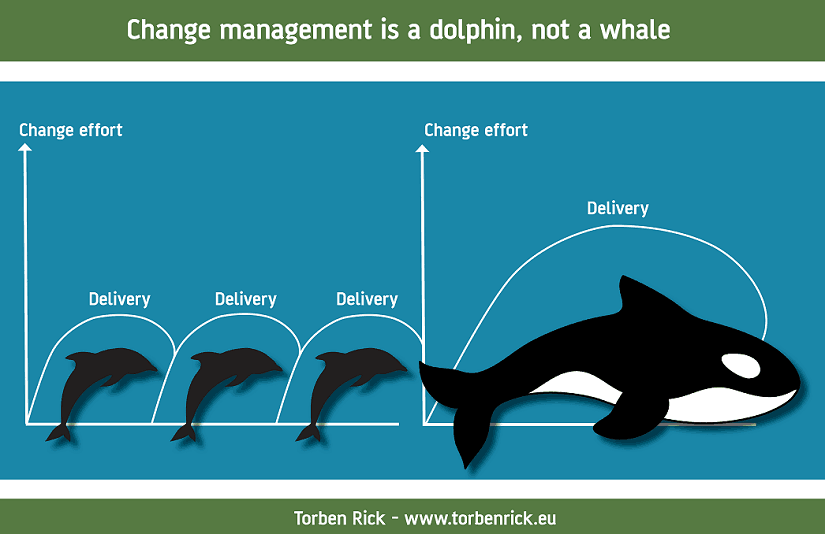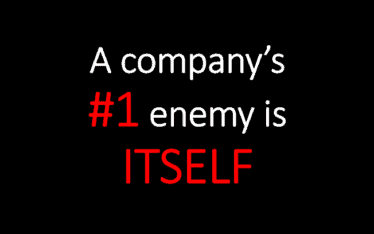Resistance to change can be a huge problem
Change is not the problem – but resistance to change can be a huge problem. In the 1920s, H.P. Lovecraft said:
The oldest and strongest emotion of mankind is fear, and the oldest and strongest kind of fear is fear of the unknown
 This quote, said over 90 years ago, still holds true today when it comes to organizational change!
This quote, said over 90 years ago, still holds true today when it comes to organizational change!
Managing change has always been difficult and will always be fraught with danger because it is so easy to introduce change the wrong way. So the logical question to ask is if there is a perfect way to introduce and manage change. The answer is no. There is no universal solution which applies to all change programmes.
Organisations are different, the reasons for change are different, timescales and budgets are different.
Each change programme will have to be implemented on its own merits. But there are things we can do to reduce the level of resistance. Ways to reduce resistance to change:
#1 – Be timely
Announce an impending change as quickly as possible – rumors start very quickly. Delivering bad news is one of the biggest challenges managers face.
#2 – The need for change
Find lots of ways to demonstrate why the change is necessary. Change management require a compelling change story – communicating it to employees and following it up with ongoing communications and involvement.
#3 – The past
You should make statements that honor the work and contributions of those who brought such success to the organization in the past, because on a very human but seldom articulated level, your audience will feel asked to betray their former mentors – whether those people remain in the organization or not. A little good diplomacy at the outset can stave off a lot of resistance.
#4 – Watch for staff reaction
Look for signals that something is not going well with the new change. Rather than trying to force a change, find out what staff doesn’t like about it. Work with their concerns or even rethink the proposed change. Change means a new way of doing things and most people are fearful of the unfamiliar. Provide assurances that there will be support and time to become familiar with the new change. It takes a while for people to adjust.
#5 – Change management should be like a dolphin, not a whale
One of the biggest roadblocks to a successful implementation of change in a business is getting the people “in the trenches” to not only understand what is coming but also to agree with what’s happening. When applied to organizational change, the “whales vs. dolphins” concept involves dividing change into a series of short steps or phases – similar to how dolphins breathe.

#6 – Involvement
Involve interested parties in the planning of change by asking them for suggestions and incorporating their ideas. If people are involved in change and understand the reasons for it they become supportive of the whole idea and the change process.
If people are given the opportunity to take responsibility and accountability for certain parts of a change programme their sense of ownership will make them even stronger advocates.
#7 – Increase engagement by asking questions
Have you ever been “talked at” instead of had someone “talk with”? It doesn’t feel good to have someone talk at you. It leaves you feeling like you might as well not have been there at all. It is much more powerful asking questions. Increase engagement by asking questions when leading change.
#8 – Communication
Lots of it. Change is unsettling because it brings with it an element of uncertainty. And it is the uncertainty which is a major cause of resistance to change. People can relate to facts – good or bad – but uncertainty and contradicting messages breed unease and resistance.
Therefore, it is important to communicate with everybody about everything in relation to the upcoming changes in order to reduce the uncertainty. Use any communication channels available and remember that it is impossible to over-communicate change.
#9 – Use social media
Social media platforms are ideal mechanisms to facilitate change because much of change management boils down to ongoing conversations and dialogue in a company.
Business leaders should start asking how can social media platforms help achieve business objectives beyond marketing: shaping company culture, strengthening change management initiatives, improving execution of corporate strategy, facilitating corporate communication, and increasing employee engagement.
#10 – Storytelling
Storytelling can be a powerful tool when you want to drive organizational change. Good leaders tell stories that “cast” them and their organizations as agents of change, rather than defenders of the status quo.
As a leader, you cannot eliminate fear, abolish uncertainty or avoid the prospect of change for your company. But you can leverage these emotional navigational stakes to your greatest advantage by telling a purposeful story.
#11 – Training programs
Deliver training programs that develop skills that is needed to support “the new way”.
#12 – Create small wins
Large change management problems are best broken down into smaller ones with concrete achievable goals. Otherwise it can be so overwhelming that solutions seem unattainable – therefore, people often avoid tackling them or come up with single, grand programs that fail. Don’t forget to pour champagne on it.
#13 – Don’t change for the sake of change
Continual change leads to resistance. Making a change for the purpose of shaking things up makes it more difficult to get acceptance of necessary changes. Save your energy for more important changes.
#14 – Don’t be afraid to change your mind
Some changes don’t turn out as well as others. Why not say “forget it”. Nothing is gained by forcing staff to accept a change they know isn’t necessary.
Short URL & title:
Top 14+ key elements in reducing resistance to change — http://www.torbenrick.eu/t/r/emo
Share it:
If you enjoyed this article, please take 5 seconds to share it on your social network. Thanks!








Hi Torben
Thanks for sharing these key elements.
I would put more emphasis on communication and should be the first key element in change management.
I would add a key element: planning. Applying changes in a company is a project by itself. The most important element in project management is planning, so planing is important in change management.
Torben: Excellent article, but I feel that communication is the key to change management. The communications should start out at a high level and working down to the detail and telling the story of ‘what’s in it for me. The more people know about the change, the more the fear of the unknown is alleviated.
I am also a firm believer that communications should be honest and let people know that they have to learn a new process, system, etc, but that resources will be given to them to make them succeed in the change endeavor.
Another big part of any change management program that I am involved is puts emphasize on the reward and recognition part. The company wants to sustain the change, so after the change goes live, reward and recognition keep the momentum going.
Change management is many faceted and involves many different processes to promote the change, but I feel that communication is a top priority from the executive sponsor down through the change manager.
Thanks. Nancy
God Eftermiddag Torben,
I too really liked your message, change if managed effectively will deliver results.
I also liked Nancy’s comments too and would add one vital ingredient to all the messages… be genuine in your messages.
I recently managed a business needing management structural change resulting in some managers moving into roles they were more suited to.Respect,humility and a genuine desire to ‘make things better’ went a long way with the staff and the moral in the company.
Tak Paul
Thanks for this thoughtful analysis of a major hurdle in change management. Sometimes I am too quick to label reaction to change as resistance when the reality is that individuals are showing a lack of enthusiasm or reticence founded in a need for more time to absorb or understand the change. The resistance label can be a cop out or avoidance mechanism for change leaders. Instead of doing the hard work of asking “why” and digging deep to understand the lack of engagement or commitment to change, we jump to the resistance rational. Unfortunately, resistance is so close to conflict that it can lead to a hardening of positions and command/control responses from leaders. Time spent on why we are getting a weak response to change or where our communications or the steps to change can be modified can be fruitful.
Thanks Dan – Very valid point!
Great point Dan. I feel resistance to change is both a cop out and a provocative term. Failure to engage or Failure to gain commitment, for me, is a far better way of describing much of what’s called Resistance and Fear. As change leaders or change management professionals gaining buy-in from the get go is far easier and far more productive than trying to batter down the percieved resistance barriers. John Kotter calls it the guiding coalition and building from small successes. Many of Torbens points will help gain that commitment. Thanks for the great article Torben.
I tend to find that some people say ‘no’ after having thought it through, having read all the information and listened to all the messages and make a reasoned choice these are the real resistors and in the planning phase some thought needs to be given on how to either win them over or move them on.
If you can’t win them over, they need to move on, and we should be helping do that. At the end…the change will happen and having a little bastion of yesterday hanging about is less that useful.